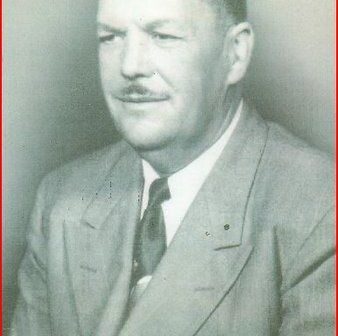
Vernon Dahmer was born on March 10, 1908, in the Kelly Settlement, Forrest County, Mississippi to Ellen Louvenia (Kelly) and George Washington Dahmer. George Dahmer was a Caucasian man identified as being an honest, hardworking man with outstanding integrity. His occupation was a farmer. Ellen Kelly was biracial because of her mother, Henrietta. Henrietta was a biracial child born out of wedlock by a white slave owner, O.B Kelly, and one of his slaves. She was given to a black family, called the McCombs.
During the Civil Rights Movement, Dahmer served two terms as president of the Forrest County Chapter of the National Association for the Advancement of Colored People (NAACP) and led voter registration drives in the 1960s. His wife Ellie said “He was a good progressive Christian man. He wasn’t a mean, bitter Civil Rights worker, because he saw good in white as well as he did in black.”
As president of the Forrest County Chapter of the NAACP, he had personally asked the Student Nonviolent Coordinating Committee (SNCC) to send workers to help aid the voter registrations efforts being made by African Americans in Hattiesburg, Mississippi. SNCC had sent two workers, Curtis Hayes and Hollis Watkins, to Hattiesburg. The act of calling SNCC to help aid the efforts made by the NAACP would eventually cost him his NAACP presidency.
In 1949 Dahmer was in the process of making out his new registration card when Luther Cox denied his attempts to re-register. Luther Cox was the authority figure in charge of registered voters in Forrest County and was a white segregationist. Cox would only authorize a registration of a black person if they could answer the question “How many bubbles are in a bar of soap?”
In 1950, fifteen leaders of Forrest County’s black community, including Dahmer, filled a lawsuit against Cox for his administration of the voting laws; preliminary injunction. Twelve years later, in March 1962, the preliminary injunction was in motion of being viewed by the court of law. Dahmer had testified in court against Luther Cox and his testimony helped demonstrate the pattern of discrimination in the county.
In the 1950s Dahmer and Medgar Evers founded a youth NAACP chapter in Hattiesburg. The student chapter did not last longer than a year. Dahmer continued to be supportive of the SNCC throughout the Civil Rights Movement. Dahmer’s farm quickly became a home away from home for SNCC volunteers. The farm was also used for registration projects and helped employ the committee volunteers. Dahmer was also working closely with the Coalition for Free and Open Elections (COFO) and the Delta Ministry.
The Dahmers had been sleeping in shifts after receiving numerous death threats throughout the year. The Dahmers had a shotgun by their nightstand in case they heard gunshots and always had the curtains drawn tight at night to make it harder for night riders to see into their home.
On January 10, 1966, the Dahmer home was attacked by the White Knights of the Ku Klux Klan. The family woke to the sound of a shotgun being discharged and the sound of gas jugs being thrown through the windows. As Ellie went to grab the children, the house erupted into fire. Dahmer returned fire from inside the house to try and distract the Klansmen while he helped hand Betty down to Ellie. He was able to leave his burning home but was severely burned from the waist up; Betty also had severe burns on her arms.
The Dahmers’ home, grocery store, and car were all destroyed in the fire. He was taken to the hospital and died due to his lungs being severely burned and smoke inhalation. Before he died, Dahmer had told a local newspaper reporter: “I’ve been active in trying to get people to register to vote. People who don’t vote are deadbeats on the state. I figure a man needs to do his own thinking. What happened to us last night can happen to anyone, white or black. At one time I didn’t think so, but I have changed my mind.”
Authorities indicted fourteen men, most with Ku Klux Klan connections, were tried for the attack on the Dahmer home. Thirteen were brought to trial, eight on charges of arson and murder. Four were convicted and Billy Roy Pitts (Sam Bowers’ body guard), who had dropped his gun at the crime scene, entered a guilty plea and had his gun turned in as state’s evidence. Billy faced just three years of his federal sentence.
However, three out of four of those convicted were pardoned within four years. In addition, eleven of the defendants were tried on federal charges of conspiracy to intimidate Dahmer because of his civil rights activities. Former Ku Klux Klan Imperial Wizard Sam Bowers, who was believed to have ordered the murder, was tried four times and each time invoked the Fifth Amendment. Each trial ended in a mistrial.
Twenty-five years after the murder of Dahmer and assault on his family, the case was reopened by the state of Mississippi. The case lasted for seven years, and ended by the conviction and sentencing to life in prison, of Imperial Wizard Bowers in 1998, Bowers died in the Mississippi State Penitentiary on November 5, 2006 at the age of 82.




